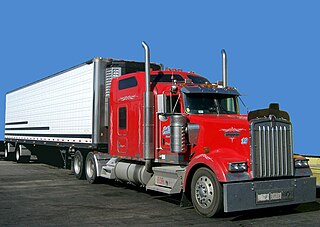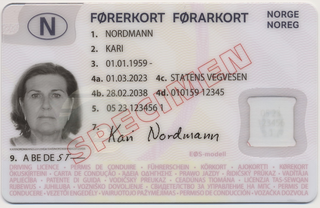
Driving is the controlled operation and movement of a land vehicle, including cars, motorcycles, trucks, and buses. A driver's permission to drive on public highways is granted based on a set of conditions being met, and drivers are required to follow the established road and traffic laws in the location they are driving. The word "driving" has etymology dating back to the 15th century. Its meaning has changed from primarily driving working animals in the 15th century to automobiles in the 1800s. Driving skills have also developed since the 15th century, with physical, mental and safety skills being required to drive. This evolution of the skills required to drive have been accompanied by the introduction of driving laws which relate not only to the driver but also to the driveability of a car.

A driving test is a procedure designed to test a person's ability to drive a motor vehicle. It exists in various forms worldwide, and is often a requirement to obtain a license to drive a vehicle independently. A driving test generally consists of one or two parts: the practical test, used to assess a person's driving ability under normal operating conditions, and a theory test to confirm a person's knowledge of driving and relevant rules and laws.

The Driving Standards Agency (DSA) was an executive agency of the UK Department for Transport (DfT).

A commercial driver's license (CDL) is a driver's license required in the United States to operate large and heavy vehicles or a vehicle of any size that transports hazardous materials or more than 15 passengers.
Graduated driver licensing systems (GDLS) are designed to provide new drivers of motor vehicles with driving experience and skills gradually over time in low-risk environments. There are typically three steps or stages through which new drivers pass. They begin by acquiring a learner's permit, progress to a restricted, probationary or provisional license, followed by receipt of a full driver's license. Graduated drivers' licensing generally restricts nighttime, expressway, and unsupervised driving during initial stages, but lifts these restrictions with time and further testing of the individual, eventually concluding with the individual attaining a full driver's license.
A driver's permit, learner's permit, learner's license or provisional license is a restricted license that is given to a person who is learning to drive, but has not yet satisfied the prerequisite to obtain a driver's license. Having a learner's permit for a certain length of time is usually one of the requirements for applying for a full driver's license. To get a learner's permit, one must typically pass a written permit test, take a basic competency test in the vehicle, or both.

A bus driver, bus operator, or bus captain is a person who drives buses for a living.

Pass Plus Scheme commonly referred to as Pass Plus is a scheme run in the United Kingdom aimed at new drivers who have recently passed the standard driving test, which helps to give drivers the confidence to drive on their own and to increase experience on the road.
Approved Driving Instructor is a UK term for a trainer of car driving who has been tested and registered by the Driver and Vehicle Standards Agency (DVSA). UK law requires driving instructors to be qualified before they can charge for their services.
The United Kingdom driving test is a test of competence that UK residents take in order to obtain a full Great Britain or Northern Ireland (car) driving licence or to add additional full entitlements to an existing one. Tests vary depending on the class of vehicle to be driven. In Great Britain it is administered by the Driver and Vehicle Standards Agency (DVSA) and in Northern Ireland by the Driver & Vehicle Agency (DVA).

Commercial driver's license training is a specialized instructional program or course designed to prepare a student to obtain a commercial driver's license (CDL), which is required for a career as a truck driver in the United States. During training, students are taught the necessary knowledge and skills to pass a series of tests to obtain their CDL. Such a program generally begins with classroom instruction geared towards passing the written exams for a CDL permit, a learner's permit that allows a student to practice driving skills on public roads with a CDL licensed driver or instructor. Students graduate from CDL training upon receiving their CDLs and proving that they can comfortably and safely drive and maneuver a truck. Most CDL training schools train drivers for a class A CDL, which allows the holder to drive a tractor trailer weighing over 26,000 pounds. Some CDL training schools incorporate truck driving simulators into their curriculum to help student drivers learn the basics of driving a truck — including shifting gears, braking, and parking.

Driver licences in Australia refer to the official permit required for a person to legally drive a motor vehicle in Australia. The issue of driver licences, alongside the regulation and enforcement of road use, are all managed by state and territory governments.
In Canada, driver's licences are issued by the government of the province or territory in which the driver is residing. Thus, specific regulations relating to driver's licences vary province to province, though overall they are quite similar. All provinces have provisions allowing non-residents to use licences issued by other provinces and territories, out-of-country licences, and International Driving Permits. Many provinces also allow non-residents to use regular licences issued by other nations and countries. Canadian driver's licences are also valid in many other countries due to various international agreements and treaties.
A driving licence in Singapore is required before a person is allowed to drive a motor vehicle of any description on a road in the country. Like many other countries in the world, an individual must possess a valid driving licence before being permitted to drive on the road, and driving licence holders are subject to all traffic rules.

Norwegian driving licences adhere to a standard set in the European Economic Area.

Swedish driving licences adhere to a standard set in the European Economic Area. 18 years is the minimum age to obtain a licence for cars.
The Driver Certificate of Professional Competence (Driver CPC) is a qualification for professional bus, coach and lorry drivers. It has been introduced across Europe with the aim of improving road safety and maintaining high standards of driving.

A driver's license, driving licence, or driving permit is a legal authorization, or the official document confirming such an authorization, for a specific individual to operate one or more types of motorized vehicles—such as motorcycles, cars, trucks, or buses—on a public road. Such licenses are often plastic and the size of a credit card.

In Germany, the driving licence ("Führerschein") is a governmental privilege given to those who request a licence for any of the categories they desire. It is required for every type of motorised vehicle with the exception of the smallest mopeds below 50 cm³, with a speed limit of 25 km/h, as well as motorised bicycles. The types of licences one may obtain are the same in all the European Economic Area. See European driving licence.
A Lebanese driving licence is a driving licence issued by the government of Lebanon. It authorises its holder to operate various types of motor vehicles on highways and some other publicly accessible roads. It is issued by each individual district.











